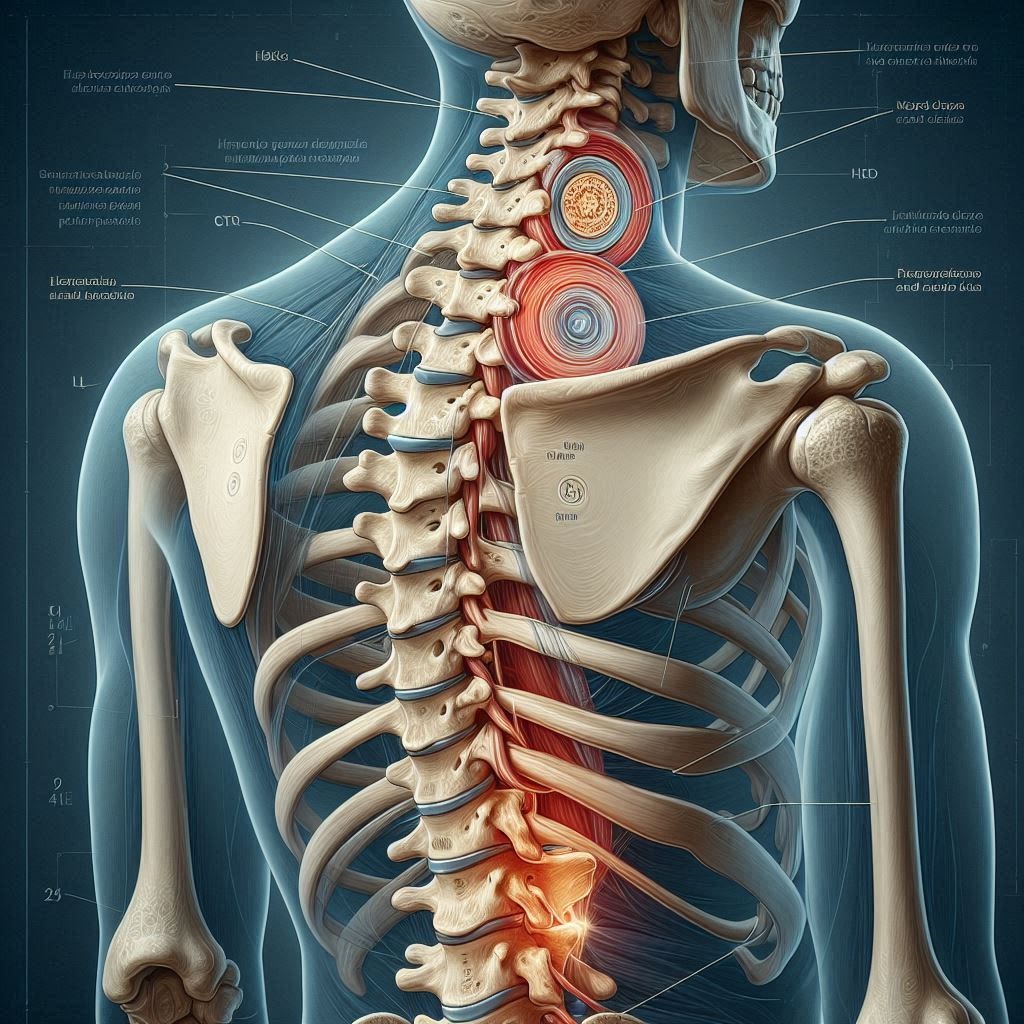Back pain is a widespread issue affecting millions of people worldwide, with estimates suggesting that up to 80% of individuals will experience it at some point in their lives. It is one of the most common reasons for missed work and medical visits. Understanding the underlying causes and effective management strategies is crucial for relief and prevention. In this discussion, we will explore how to relief back pain, focusing on exercises, posture, and awareness techniques to promote better spinal health.
Underlying Mechanisms Of Back Pain
Back pain is a multifaceted condition with various underlying mechanisms. These mechanisms can be broadly categorized into structural, neurological, biochemical, and psychological factors. Here is a detailed overview of the underlying mechanisms of back pain:
Structural Mechanisms
-
- Muscle Strain: Overuse, poor posture, or sudden movements can strain muscles, causing pain.
-
- Ligament Sprain: Stretching or tearing of ligaments supporting the spine can lead to pain and instability.
-
- Intervertebral Disc Degeneration: Age-related wear and tear of discs can cause them to lose flexibility and cushioning ability, leading to pain.
-
- Herniated Disc: A bulging or ruptured disc can press on spinal nerves, causing pain.
-
- Spinal Stenosis: Narrowing of the spinal canal can compress nerves, leading to pain and neurological symptoms.
-
- Spondylolisthesis: A condition where one vertebra slips over another, potentially compressing nerves.
Neurological Mechanisms
-
- Radiculopathy: Compression or irritation of spinal nerve roots can cause pain, numbness, and weakness along the affected nerve pathway.
-
- Sciatica: Compression of the sciatic nerve, often due to a herniated disc or spinal stenosis, leading to pain radiating down the leg.
-
- Peripheral Sensitization: Enhanced sensitivity of peripheral nerves can lead to increased pain perception.
-
- Central Sensitization: Changes in the central nervous system (CNS) can amplify pain signals, making normal sensations painful (allodynia) and increasing pain intensity (hyperalgesia).
Biochemical Mechanisms
-
- Pro-inflammatory Cytokines: Chemicals released during injury or inflammation can sensitize nerves and enhance pain transmission.
-
- Neuroinflammation: Inflammation within the nervous system can contribute to chronic pain.
-
- Glutamate: Excessive levels of this excitatory neurotransmitter can enhance pain signal transmission.
-
- Substance P: Involved in transmitting pain signals; increased levels can amplify pain perception.
Psychological Mechanisms
-
- Stress and Anxiety: Can exacerbate pain perception by increasing muscle tension and sensitizing pain pathways.
-
- Depression: Associated with lower pain thresholds and increased pain perception.
-
- Catastrophizing: Negative thought patterns about pain can increase its intensity and chronicity.
-
- Attention and Distraction: Focusing on pain can increase its perception, while distraction can reduce it.
Environmental and Social Factors
-
- Physical Activity: A sedentary lifestyle or overexertion can contribute to back pain.
-
- Ergonomics: Poor workstation setup and improper lifting techniques can lead to back pain.
-
- Support Systems: Lack of social support can exacerbate pain perception and coping ability.
Read: How To Structure Your Sleep And Use Naps?: A Detailed Guide
How To Relief Back Pain?
There are various methods that can help in the prevention and treatment of back pain. The most effective exercises and methodologies are discussed below in detail.
Abdominal Stability for Back Pain Relief: Curl-up Exercise
The curl-up exercise effectively enhances abdominal stability, which is crucial for reducing back pain. It strengthens the core muscles, providing better support for the spine and reducing the risk of strain and injury.
How to Perform:
-
- Lie on your back with one knee bent and the other leg straight.
-
- Place your hands under the small of your back.
-
- Slowly lift your head, shoulders, and chest slightly off the ground, keeping your lower back in a neutral position.
-
- Hold for a few seconds, then lower back down.
Benefits:
-
- Strengthens the rectus abdominis and oblique muscles.
-
- Enhances spinal stability and support.
-
- Reduces the likelihood of back pain recurrence.
Back Pain Prevention: Understanding Disc Herniations

Disc herniations occur when the intervertebral disc’s inner gel-like material protrudes through its outer layer, often compressing nearby nerves. Causes include aging, improper lifting, and repetitive stress.
Prevention Methods:
-
- Proper Lifting Techniques: Use your legs, not your back, to lift heavy objects.
-
- Regular Exercise: Strengthen core and back muscles to support the spine.
-
- Posture Awareness: Maintain good posture while sitting, standing, and sleeping.
-
- Ergonomic Adjustments: Ensure workspaces are set up to reduce strain on the back.
Cobra Push-ups for Disc Bulge Reversal and Back Pain Management
Cobra push-ups are effective in managing disc bulges and alleviating back pain by promoting spinal extension and relieving pressure on the discs.
How to Perform:
-
- Lie face down with your hands under your shoulders.
-
- Press your hands into the ground, lifting your chest while keeping your hips on the floor.
-
- Hold for a few seconds, then lower back down.
Benefits:
-
- Encourages spinal extension and disc retraction.
-
- Reduces nerve compression and associated pain.
-
- Improves flexibility and strength of the lower back.
Bird Dog Exercise for Core Strength and Spinal Stability
The bird dog exercise enhances core strength and spinal stability by targeting the back, glutes, and abdominal muscles.
How to Perform:
-
- Start on all fours with your hands under your shoulders and knees under your hips.
-
- Extend one arm forward and the opposite leg backward, keeping your spine neutral.
-
- Hold for a few seconds, then return to the starting position and switch sides.
Benefits:
-
- Strengthens the core and stabilizes the spine.
-
- Improves balance and coordination.
-
- Reduces the risk of back injuries and pain.
Core Strengthening: Spinal Erector Muscles
Strengthening the spinal erector muscles is vital for maintaining spinal stability and preventing back pain. Exercises like deadlifts, back extensions, and good mornings specifically target these muscles.
Deadlifts:
-
- Strengthen the entire posterior chain, including the spinal erectors.
-
- Promote proper lifting mechanics and spinal alignment.
Back Extensions:
-
- Focus on isolating and strengthening the lower back muscles.
-
- Can be performed on a stability ball or back extension machine.
Good Mornings:
-
- Target the lower back, hamstrings, and glutes.
-
- Ensure proper form to avoid excessive spinal stress.
Hanging for Spine Lengthening and Pain Relief
Hanging from a bar can help decompress the spine, alleviate pain, and improve overall spinal health.
How to Perform:
-
- Find a stable overhead bar.
-
- Grip the bar with both hands and let your body hang freely.
-
- Hold the position for 20-30 seconds, gradually increasing the duration as comfortable.
Benefits:
-
- Decompresses the spine and reduces pressure on intervertebral discs.
-
- Improves grip strength and shoulder stability.
-
- Enhances overall spinal alignment and posture.
Neck Strengthening for Spinal Stability
Strengthening neck muscles can improve overall spinal stability and reduce the risk of neck and back pain.
Exercises:
-
- Chin Tucks: Pull your chin back to create a double chin, holding for a few seconds.
-
- Neck Flexion and Extension: Gently nod your head forward and backward.
Benefits:
-
- Enhances neck stability and posture.
-
- Reduces strain on the cervical spine.
-
- Prevents neck-related back pain.
Rotator Cuff Strengthening: Arm Chest Reach
The arm-chest reach exercise targets the rotator cuff muscles, enhancing shoulder stability and reducing the risk of upper back pain.
How to Perform:
-
- Lie on your back with one arm reaching across your chest.
-
- Use the other hand to gently pull the reaching arm towards the opposite side.
-
- Hold for a few seconds, then switch sides.
Benefits:
-
- Strengthens the rotator cuff and shoulder stabilizers.
-
- Improves shoulder mobility and reduces pain.
-
- Supports overall upper back health.
Foot and Toe Flexibility for Spine Support
Improving foot and toe flexibility can positively impact spine support and overall posture.
Exercises:
-
- Toe Stretches: Stretch and wiggle your toes regularly.
-
- Foot Rolls: Roll your foot over a tennis ball to massage and stretch the arch.
Benefits:
-
- Enhances balance and alignment.
-
- Reduces strain on the spine from improper foot mechanics.
-
- Supports overall spinal health.
Oblique Active Bracing for Weightlifting
Active bracing of the oblique muscles during weightlifting helps stabilize the spine and prevent injuries.
How to Perform:
-
- Engage your core and oblique muscles before lifting.
-
- Maintain this tension throughout the lift to support your spine.
Benefits:
-
- Provides additional spinal stability.
-
- Reduces the risk of back injuries during heavy lifting.
-
- Improves overall lifting performance and safety.
Spinal Architecture and Function: Understanding Simple Movements
Understanding the spine’s basic movements and functions is essential for maintaining back health.
Movements:
-
- Flexion and Extension: Bending forward and backward.
-
- Lateral Flexion: Bending side to side.
-
- Rotation: Twisting the spine.
Functions:
-
- Provides structural support and stability.
-
- Protects the spinal cord.
-
- Allows flexibility and movement.
Alternative Exercises to Aid Back Pain Relief: Exploring the Big Three

The “Big Three” exercises, popularized by Dr. Stuart McGill, are highly effective for back pain relief and prevention.
-
- Curl-up:
Strengthens the abdominal muscles without straining the lower back.
-
- Side Plank:
Targets the oblique muscles and enhances lateral stability.
-
- Bird Dog:
-
- Improves core strength and spinal stability.], K MM
Advantages:
-
- Low Risk: Minimizes the risk of injury compared to traditional exercises.
-
- High Efficacy: Effectively strengthens the core and stabilizes the spine.
-
- Versatility: Can be modified to suit different fitness levels.
Read: How Smartphones Impact Mental Health?: The Realistic Solutions
Conclusion
Maintaining spinal strength and awareness is key to preventing and reducing back pain. Understanding its diverse causes aids in effective management. Core-strengthening exercises like curl-ups, bird dog, and cobra push-ups enhance stability and relieve pain. Proper posture, movement awareness, and ergonomic practices further support spinal health. Movement specialists offer essential guidance. Techniques such as hanging for spine lengthening and strengthening neck and rotator cuff muscles also contribute to overall spine support. Integrating these strategies promotes better back health and quality of life.
